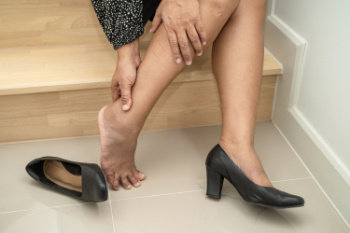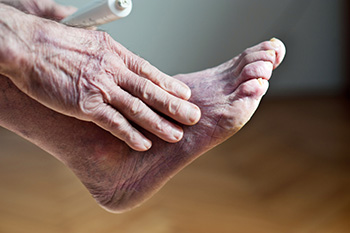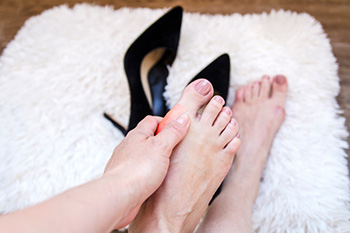Dallas (214) 340-8885
Athens (903) 677-9090
Gun Barrel City (903) 887-4341
Dallas (214) 340-8885
Athens (903) 677-9090
Gun Barrel City (903) 887-4341

Foot pain can be attributed to several causes that often affect individuals irrespective of age or lifestyle. Plantar fasciitis, a condition characterized by inflammation of the tissue connecting the heel bone to the toes, can lead to stabbing pain upon standing. Another common offender is bunions, the bony protrusions that form at the base of the big toe, causing discomfort and altering foot structure. Arthritis, an inflammatory joint condition, can afflict the feet, resulting in persistent pain and reduced mobility. Strained or overworked muscles, often a consequence of prolonged standing or intense physical activity, can contribute to general foot soreness. Wearing ill-fitting footwear, such as tight shoes or high heels, can also be a frequent source of pain. Understanding these common triggers for foot discomfort is essential for effective prevention and management. If you have foot pain for any reason, it is strongly suggested that you schedule an appointment with a podiatrist who can determine the cause and offer effective treatment methods.
Foot Pain
Foot pain can be extremely painful and debilitating. If you have a foot pain, consult with Dr. Jonathan Kletz from Texas Foot Works. Our doctor will assess your condition and provide you with quality foot and ankle treatment.
Causes
Foot pain is a very broad condition that could be caused by one or more ailments. The most common include:
Diagnosis
To figure out the cause of foot pain, podiatrists utilize several different methods. This can range from simple visual inspections and sensation tests to X-rays and MRI scans. Prior medical history, family medical history, and any recent physical traumatic events will all be taken into consideration for a proper diagnosis.
Treatment
Treatment depends upon the cause of the foot pain. Whether it is resting, staying off the foot, or having surgery; podiatrists have a number of treatment options available for foot pain.
If you have any questions, please feel free to contact one of our our offices located in Dallas, Athens, and Gun Barrel City, TX . We offer the newest diagnostic and treatment technologies for all your foot care needs.

Poor circulation in the feet, often a symptom of underlying health conditions such as diabetes or peripheral artery disease, can lead to a variety of foot-related issues. Symptoms can include cold feet, numbness, changes in skin color, and slow wound healing. Without adequate blood flow, feet may not receive enough oxygen and nutrients, which can cause discomfort and increase the risk of infections and ulcers. It is important to manage underlying conditions, maintain a healthy lifestyle, and regularly check your feet for any changes or signs of problems. If you have symptoms of poor foot circulation, it is suggested that you make an appointment with a podiatrist who can diagnose what the cause is, and offer effective treatment options.
Poor circulation is a serious condition and needs immediate medical attention. If you have any concerns with poor circulation in your feet contact Dr. Jonathan Kletz of Texas Foot Works. Our doctor will treat your foot and ankle needs.
Poor Circulation in the Feet
Poor blood circulation in the feet and legs is can be caused by peripheral artery disease (PAD), which is the result of a buildup of plaque in the arteries.
Plaque buildup or atherosclerosis results from excess calcium and cholesterol in the bloodstream. This can restrict the amount of blood which can flow through the arteries. Poor blood circulation in the feet and legs are sometimes caused by inflammation in the blood vessels, known as vasculitis.
Causes
Lack of oxygen and oxygen from poor blood circulation restricts muscle growth and development. It can also cause:
Those who have diabetes or smoke are at greatest risk for poor circulation, as are those who are over 50. If you have poor circulation in the feet and legs it may be caused by PAD and is important to make changes to your lifestyle in order to reduce risk of getting a heart attack or stroke. Exercise and maintaining a healthy lifestyle will dramatically improve conditions.
As always, see a podiatrist as he or she will assist in finding a regimen that suits you. A podiatrist can also prescribe you any needed medication.
If you have any questions please feel free to contact one of our our offices located in Dallas, Athens, and Gun Barrel City, TX . We offer the newest diagnostic and treatment technologies for all your foot and ankle needs.

Foot drop is a condition that affects the ability to lift the front part of the foot and can hinder carrying out various daily activities. The main symptom of foot drop is a distinct walking pattern called steppage gait, similar to marching. It happens when individuals compensate for the difficulty in foot lifting by raising their thighs more than usual, resulting in a noticeable foot slap with each step. Numbness on the top of the foot and toes may accompany this gait abnormality. Foot drop can affect one or both feet and stems from various causes. Included are nerve injuries due to compression in the leg from injuries or surgery and nerve root injuries in the spine, more common among individuals with diabetes. Other conditions like muscular dystrophy or neurologic disorders such as polio, may cause foot drop. Moreover, disorders affecting the brain or spinal cord, such as stroke or multiple sclerosis, may contribute to this gait disorder. It may call for a team of medical professionals to manage foot drop. One of these is a podiatrist, who is trained to detect and manage foot drop. For more information and an examination, it is suggested that you schedule an appointment with a podiatrist who can offer treatment suggestions.
If you have any concerns about your feet, contact Dr. Jonathan Kletz from Texas Foot Works. Our doctor can provide the care you need to keep you pain-free and on your feet.
Biomechanics in Podiatry
Podiatric biomechanics is a particular sector of specialty podiatry with licensed practitioners who are trained to diagnose and treat conditions affecting the foot, ankle and lower leg. Biomechanics deals with the forces that act against the body, causing an interference with the biological structures. It focuses on the movement of the ankle, the foot and the forces that interact with them.
A History of Biomechanics
Modern technological improvements are based on past theories and therapeutic processes that provide a better understanding of podiatric concepts for biomechanics. Computers can provide accurate information about the forces and patterns of the feet and lower legs.
Understanding biomechanics of the feet can help improve and eliminate pain, stopping further stress to the foot.
If you have any questions please feel free to contact one of our our offices located in Dallas, Athens, and Gun Barrel City, TX . We offer the newest diagnostic and treatment technologies for all your foot and ankle needs.

Gout, a form of arthritis caused by the accumulation of uric acid crystals in the joints, necessitates careful consideration of dietary choices, including vegetable consumption. Opting for vegetables rich in fiber and low in purines is key for managing gout. Leafy greens such as kale, spinach, and swiss chard are excellent choices, offering essential nutrients without significantly impacting uric acid levels. Cruciferous vegetables like broccoli and cauliflower also make gout-friendly additions to the plate. However, moderation is advised with certain vegetables high in purines, such as asparagus and mushrooms, as they may contribute to uric acid buildup. If you have experienced one or more gout attacks, it is strongly suggested that you are under the care of a podiatrist who can help you to manage this condition, including discussing appropriate food choices.
Gout is a painful condition that can be treated. If you are seeking treatment, contact Dr. Jonathan Kletz from Texas Foot Works. Our doctor will treat your foot and ankle needs.
What Is Gout?
Gout is a form of arthritis that is characterized by sudden, severe attacks of pain, redness, and tenderness in the joints. The condition usually affects the joint at the base of the big toe. A gout attack can occur at any random time, such as the middle of the night while you are asleep.
Symptoms
Risk Factors
Prior to visiting your podiatrist to receive treatment for gout, there are a few things you should do beforehand. If you have gout you should write down your symptoms--including when they started and how often you experience them, important medical information you may have, and any questions you may have. Writing down these three things will help your podiatrist in assessing your specific situation so that he or she may provide the best route of treatment for you.
If you have any questions, please feel free to contact one of our our offices located in Dallas, Athens, and Gun Barrel City, TX . We offer the newest diagnostic and treatment technologies for all your foot care needs.

A recent study shows that nearly 40 percent of women wear high heels every day. However, this fashion choice comes at a cost, with 75 percent of these women reporting regular foot pain and various foot deformities. The narrow toe box inherent in most high-heeled shoes is believed to be the main cause. This constrictive design makes it challenging for women to comfortably fit their entire foot into the shoe, leading to toe deformities, such as bunions, hammertoes, and calluses. While heredity plays a large role in the formation of a bunion, external pressure from shoes with a small toe box can make it worse. When conservative measures fail, surgery may be necessary to realign the joint and distribute weight more evenly across the foot. High heels also bend the toes upward, exposing more bone to the bottom of the shoes and causing significant pain. Additionally, the frequent use of high heels is linked to tight calf muscles, which pave the way for other painful foot problems like plantar fasciitis, flat feet, and Achilles tendonitis. For help with any of the above mentioned foot problems, it is suggested that you schedule an appointment with a podiatrist for an exam and treatment options.
High heels have a history of causing foot and ankle problems. If you have any concerns about your feet or ankles, contact Dr. Jonathan Kletz from Texas Foot Works. Our doctor can provide the care you need to keep you pain-free and on your feet.
Effects of High Heels on the Feet
High heels are popular shoes among women because of their many styles and societal appeal. Despite this, high heels can still cause many health problems if worn too frequently.
Which Parts of My Body Will Be Affected by High Heels?
What Kinds of Foot Problems Can Develop from Wearing High Heels?
How Can I Still Wear High Heels and Maintain Foot Health?
If you want to wear high heeled shoes, make sure that you are not wearing them every day, as this will help prevent long term physical problems. Try wearing thicker heels as opposed to stilettos to distribute weight more evenly across the feet. Always make sure you are wearing the proper shoes for the right occasion, such as sneakers for exercising. If you walk to work, try carrying your heels with you and changing into them once you arrive at work. Adding inserts to your heels can help cushion your feet and absorb shock. Full foot inserts or metatarsal pads are available.
If you have any questions please feel free to contact one of our our offices located in Dallas, Athens, and Gun Barrel City, TX . We offer the newest diagnostic and treatment technologies for all your foot and ankle needs.